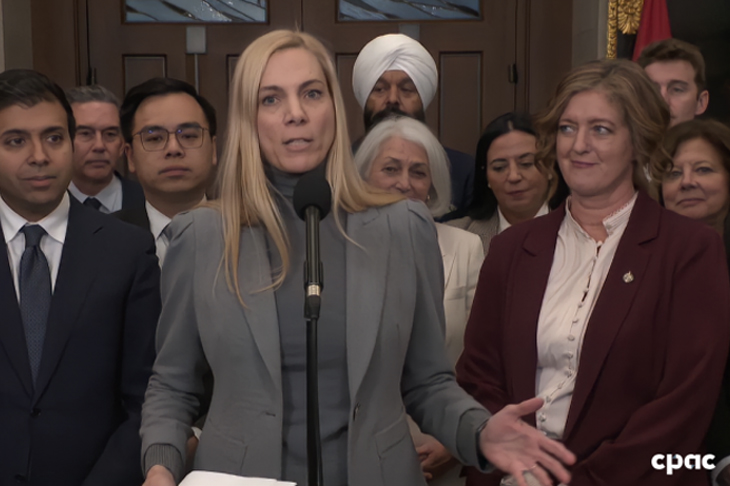And what still stands in their way
By Greg O’Brien
THE PURCHASE OF SHAW by Rogers has been a steady recurrent rumour which would crop up from time to time over the past 23-plus years this reporter has been tracking the industry, meaning Monday’s $26 billion purchase deal by Rogers was a long, long time coming.
In fact, when I first spoke with former Shaw president Peter Bissonnette in late 1997 (so long ago I don’t think he had yet been appointed president), I asked him then about the rumour I heard Rogers would buy Shaw. Too soon. Much too soon, as it turns out.
The two companies, led by entrepreneurial business legends Ted Rogers and JR Shaw (above), would get together three years after my meeting with Mr. Bissonnette to swap cable systems where Rogers received Shaw’s then large southern Ontario cable systems (including Richmond Hill, for example), as well as New Brunswick, and Shaw took over Rogers’s Vancouver cable systems. The move would consolidate their positions in the east and west and set each on unprecedented growth curves.
While some spun the two companies as rivals, that wasn’t really true most of the time. Rogers and Shaw, especially under their founders, acted more like cable brothers (sometimes playing practical jokes on one another) but perhaps when the last surviving brother, JR, died a year ago this month at 85, the Shaw family, along with its board and management, decided it was time for the bigger company to take the wheel. Ted, after all, moved into a business which exploded (wireless) which JR’s company did not jump into until much later – and make no mistake, wireless is the most important driver of this transaction.
Of course, Rogers will nearly double in size on the wireline side, with a combined network passing 8.9 million homes with 4.7 million internet subscribers, but wireless needs a strong, well-distributed, wired backbone and Shaw’s extensive western networks are just what the budding 5G technology will need. (Gaining a wired network in Ontario’s Golden Horseshoe and in southern Quebec to aid in the deployment of 5G was a big part of the reason Rogers wanted Cogeco so desperately.)
Shaw CEO Brad Shaw, JR’s youngest son, told Cartt.ca his company made the first move towards Rogers in late summer after considering its long-term options and seeing new complexity, and expense, on the horizon, in a field where much larger players are generally driving the bus.
“I think there always was a realization there would be a time, a moment, where it made sense for Shaw to look at some type of merg er or something where we can really participate in a bigger game,” he said Monday.
er or something where we can really participate in a bigger game,” he said Monday.
As part of that bigger game, Rogers is not just buying the company. It has made a number of important, expensive commitments to western Canada. As long as the deal goes through, it has promised to create a $1 billion Rogers Rural and Indigenous Connectivity Fund; that Freedom Mobile prices will not budge for three years; a new National Centre of Technology and Engineering Excellence, located in Calgary will be created; and a western headquarters will be maintained at Shaw Court in Calgary (pictured).
Brad Shaw will also be made a member of the Rogers board and will have the right to name an additional Rogers director as the Shaw family will become one of Rogers’ largest shareholders.
Rogers also pledged to spend billions on network upgrades, both wired and wireless, but that would have to happen anyway, even without the Shaw purchase.
“I think JR would be proud.” – Brad Shaw
As for the Shaw family itself, CEO Brad said it was very important for them to make a deal that was fair to its customers and western Canadians, too. “I think western Canada is going to be way better off, Alberta is going to be better off, Calgary is going to be better off… when you look at 5G, IoT, and the new products and services coming from that, it’s really exciting, and (this deal) is going to accelerate things beyond what Shaw could do by itself.”
But, what would founder JR think of this?
“I think JR would be proud. As a founder, it’s sometimes not that easy to look at the next chapter and this is something we’ve talked about. I think he would look down and Jim would look down and say ‘good job. Very good job’.
“It’s pretty important to the family that we can hold our heads high and walk away here and be proud of everything we’ve done.”
All of that said, the deal is not scheduled to close until early 2022, reflecting the regulatory hurdles the deal has to clear with the federal government and the CRTC – the most important of which will be the Competition Bureau.
The federal government has for years, dating back to the prior Conservative government, maintained a policy of having four wireless carriers per region – saying more competition means lower prices for consumers. In 2017 when Bell Canada purchased Manitoba’s MTS, the Bureau forced Bell to divest wireless spectrum, customers and even stores to Telus and Xplornet (which is what launched Xplore Mobile), so that Manitoba, with 4.3% of Canada’s population would hit that magic number of four wireless companies.
“We feel confident this transaction will be approved.” – Joe Natale, Rogers
This deal, if approved as-is, would see Shaw’s Freedom Mobile removed as an independent fourth player in Ontario, Alberta and B.C., which collectively make up 67% if the country’s population.
Nevertheless, “we feel confident this transaction will be approved,” Rogers CEO Joe Natale told analysts during a Monday morning conference call, setting up the position he’ll take with regulators. “We expect the review to take between nine and 12 months… Bell-MTS took about 11 months or so, but it’s important to bear in mind that that 80% of Shaw’s revenues and 97% of its free cash flow are earned from the wireline business, which does not compete directly with Rogers.
“We’re going to work collaboratively with the regulators,” he continued. “We’ll be constructive in that engagement… always looking through the eyes and the lens of the government and the regulators and trying to figure out what is a smart outcome that makes sense for Canada, makes sense for consumers, and makes sense for the combined company.”
So one of two things seem sure to happen.
1. The Bureau will force some sort of wireless divestiture. That would create possible opportunities for the likes of Videotron to grow beyond Quebec, for Eastlink to grow beyond its current borders (besides its main eastern operations it also provides wireless service in Grande Prairie, Alta., for example, where it also has a wired presence), for Xplore Mobile to get bigger, and for Cogeco (in which Rogers still owns a significant interest) to get into wireless.
There would also be the option to sell Freedom outright to a foreign buyer. Canadian laws permit an outsider to purchase a Canadian telecom with less than 10% market share and Freedom currently has around 6% share of the Canadian wireless market, but inviting a foreign company into Canada to compete with them seems like a far-fetched idea.
2. The federal government walks away from the four-wireless-carriers-per-region idea. The feds could point at how wireless prices are falling, claim success, promise to be vigilant, and approve the deal. After all, Freedom used to be Wind Mobile, which was born at the same time as Public Mobile (now Telus) and Mobilicity (subsumed by Rogers), which were allowed to be purchased by incumbents.
This would surely then cause other dominoes to fall as other regional operators could then look to sell. The feds could look to open up foreign investment in telecom, but there have been absolutely no signals from the federal government it is interested in that move.
One thing the federal government will have to consider in all this is the goodies promised by Rogers Monday may well disappear or be pared back if they tie too many conditions to the proposed merger, or force divestitures. The incentives announced with the deal today (especially the $1 billion rural connectivity fund for western Canada, which is bigger than the CRTC’s national $750 million broadband fund) may be too good to pass up and post-pandemic, the federal government might now be thinking it needs Big Telecom to connect everyone.
An additional, very important, pending quandary presented by this proposed transaction involves the federal government’s June 3500 MHz spectrum auction. As a smaller “new entrant” Shaw and others are allowed to bid on spectrum set aside only for them to bid on – making their purchases cheaper than the non-set-aside spectrum open for anyone to bid on and which all three of Rogers, Bell and Telus dearly want.
ISED will now have to consider whether it’s fair for Shaw to purchase spectrum on the cheap when it might end up in Rogers’ hands in short order. Or, will Shaw not be allowed to bid after all, or will it decline to bid, which might leave some spectrum blocks unsold? Neither Brad Shaw nor Joe Natale would comment whatsoever on anything about the auction because they have to stay completely tight lipped or risk being thrown out of the it, according to the rules.
The CRTC will also consider the competitive issues and during its public proceeding to consider the deal, and we expect broadcasters to present concerns, given how the new Rogers will have over 3.5 million TV subscribers, which also includes Shaw Direct satellite TV, and give it make-or-break power over TV channel owners. (An earlier version of this story had a higher number of TV subscribers, but a researcher contacted us and pointed out it’s more likely around 3.5 million)
Analysts are bullish about the deal and share prices of both companies rose during trading on Monday, Shaw’s by close to 10%.
“With the synergies and the deal over 90% financed with cash, the acquisition should be very accretive for RCI,” wrote Scotiabank’s Jeff Fan in a note to investors. “The transaction combines Rogers’ and Shaw’s wireless networks, which we believe will become a relatively stronger 5G competitor relative to being independent over the long term.
“Is it possible that the CRTC re-evaluates its position, given this potentially significant change to the industry structure?” – Jeff Fan, Scotiabank
“We are surprised about the timing of this deal,” Fan continued, “primarily due to the upcoming spectrum auction and CRTC MVNO decision. With this announcement, is Shaw still eligible to bid in the set aside blocks in the 3.5 GHz auction in June? And if not, will there be leftover licenses and in that case what will ISED do? The CRTC still have not issued its MVNO decision and is it possible that the CRTC re-evaluates its position, given this potentially significant change to the industry structure?”
“We think the proposed combination is highly attractive to Rogers from a strategic perspective as it delivers national scale,” wrote BMO Capital Markets analyst Tim Casey to investors.
“We believe the transaction carries strong strategic and operational benefits to Rogers as it effectively doubles its wireline footprint and provides national scale. Moreover, the combined entity will be much better positioned to deploy and leverage 5G wireless technology over the medium term.
“Based on current expectations, the combined entity would generate ~$21B in revenue and almost $9B in EBITDA… before any synergies.”
Neither see a competitive bid emerging since the Shaw Family has already bound themselves to this deal.
Photo of company founders Ted Rogers (left) and JR Shaw, courtesy Rogers Communications.









